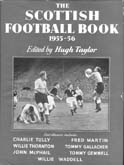football annuals
Fitba Daft
Growing up in Glasgow in the Fifties and Sixties, Christmas meant one thing to me. Football books – and lots of them. The process started in late autumn when, unknown to me, my mother would start to scour the bookshops to see which titles were available. She would then allocate one title each to a family member or friend to purchase for me as a Christmas gift. So it was that on Christmas morning I would be able to catch up with all my favourite football annuals. Charles Buchan’s Football Book, The Topical Times Football Annual, The International Football Book and, most importantly, Hugh Taylor’s Scottish Football Book.The last-named title included information on all the teams and players that I watched week in week out from the terraces. With any luck, there might even be an article on my beloved Partick Thistle.
Hugh Taylor was a sports journalist who hit on the idea of producing a Scottish football annual, and convinced the London publishers Stanley Paul – who already had a large back catalogue of general sports books – to publish it. The first edition was published in 1956. It was a reasonable success and the following year the second edition duly followed. In fact, the format was so popular that it was to continue more or less along the same lines for over thirty years.
The content remained similar for all that time – a mix of articles on Scottish club and international matters, some penned by well known journalists and some by the star players of the day. (It would be safe to assume that the latter would be ghost-written by the self-same local hacks.) in the early years photographic content was kept separate from the text, printed six or eight pages at a time on glossy paper, but from the fourth year the illustrations were printed on matt paper and included alongside the text.
There were to be few changes over the next twenty years or so. It wasn’t until the mid-Seventies that the format changed from hardback to softback and colour photographs were added. By this time it was becoming obvious that the series’ days were numbered; the annuals seemed to have fewer pages each year.
 The Scottish Football Book changed format through the years from the hardback annual of the Fifties (left) to the 1981 paperback (below).
The Scottish Football Book changed format through the years from the hardback annual of the Fifties (left) to the 1981 paperback (below).
The selection of soccer books available would have given my poor mother a heart attack. Professional football had changed and the top clubs had seen the opportunity to make some extra money by publishing their own annuals. In Scotland the ‘Playing for Rangers’ and Playing for Celtic’ series were particularly successful. Supporters of the old firm were, it seemed, only interested in reading about their own players and club. The age of football commercialism was upon us.
 During its lifespan, one or two attempts were made to produce opposition tomes. In the late Sixties and early Seventies, both the Scottish Daily Record and Scottish Television Scots Sport programme briefly produced annuals in direct t opposition to the Hugh Taylor imprint. Both were seen off. Since its demise a few attempts have been made to revive the format. As recently as last year the Glasgow Evening Times produced The Big Red Book, a sister publication to the successful Wee Red Book. But the signs do not look good. Most stores seemed to have piles of the publications left in the New Year and I suspect that the remainder shops can look out for what’s left coming their way at much reduced rates.
During its lifespan, one or two attempts were made to produce opposition tomes. In the late Sixties and early Seventies, both the Scottish Daily Record and Scottish Television Scots Sport programme briefly produced annuals in direct t opposition to the Hugh Taylor imprint. Both were seen off. Since its demise a few attempts have been made to revive the format. As recently as last year the Glasgow Evening Times produced The Big Red Book, a sister publication to the successful Wee Red Book. But the signs do not look good. Most stores seemed to have piles of the publications left in the New Year and I suspect that the remainder shops can look out for what’s left coming their way at much reduced rates.
In the meantime the early editions of Hugh Taylor’s Annual have become sought-after collector’s items. As with many books that were aimed at the youth market, condition is the main problem. The early editions came with dust jackets and these are now usually missing or hopelessly tatty. The inside photographs are also often missing or defaced. Small boys had a habit of doing terrible things to photographs of opposition players and it is often possible to make an educated guess as to which team the original owner supported.
I am writing this article in the aftermath of the Scottish team’s woeful performance in the Faroe Islands. A look back through the annuals of the last forty years is a chastening experience.
Copyright Alan Cunningham 2005.

Comments